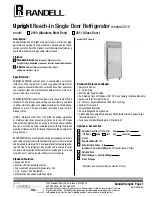
16
Temperature is too warm
■
New installation - Following installation, allow 24 hours for the refrigerator and freezer to cool
completely.
NOTE: Adjusting the temperature control(s) to the coldest setting will not cool either
compartment (refrigerator or freezer) more quickly.
■
Doors are opened often or not closed completely - This allows warm air to enter the
refrigerator. Minimize door openings, keep the doors fully closed, and make sure both doors are
properly sealed.
■
Air vents are blocked - Remove items that are immediately in front of the vents.
■
Large amount of warm food recently added - Allow several hours for the refrigerator to return
to its normal temperature.
■
Controls are not set correctly for the surrounding conditions - Adjust the controls to a colder
setting. Check the temperature again in 24 hours.
Temperature is too cold
■
Controls are not set correctly for the surrounding conditions - Adjust the controls to a
warmer setting. Check the temperature again in 24 hours.
■
Top refrigerator shelf is colder than lower shelves - On some models, air from the freezer
enters the refrigerator compartment through vents near the top refrigerator shelf. As a result, the
top shelf can be slightly colder than lower shelves.
■
Air vents are blocked - Remove items that are immediately in front of the vents.
Interior moisture buildup
NOTE: Some moisture buildup is normal. Clean with a soft dry cloth.
■
Room is humid - A humid environment contributes to moisture buildup. Use the refrigerator only
in an indoor location, with as little humidity as possible.
■
Doors are opened often or not closed completely - This allows humid air to enter the
refrigerator. Minimize door openings, keep the doors fully closed, and make sure both doors are
properly sealed.
Interior lights do not work
■
Doors have been open for an extended period of time - Close the doors to reset the lights.
■
Light bulb is loose in the socket or has burned out - On models with incandescent interior
light bulbs, tighten or replace the bulb. See “Lights.”
NOTE: On models with LED lights, call for assistance or service if the interior lights do not illuminate
when either door is opened. See either the front cover or the Warranty for contact information.
Dispenser lights
do not work
(on some models)
■
Dispenser light is turned off - On some models, if the dispenser light is set to OFF, the light will
turn on only when a dispenser pad/lever is pressed. If you want the dispenser light to stay on
continuously, select a different setting. See “Water and Ice Dispensers.”
■
Dispenser light is set to AUTO or NIGHT LIGHT - On some models, if the dispenser light is set
to AUTO or NIGHT LIGHT, make sure the dispenser light sensor is not blocked. See “Water and
Ice Dispensers.”
NOTE: On models with LED lights, call for assistance or service if the dispenser lights do not operate
correctly. See either the front cover or the Warranty for contact information.
DOORS AND LEVELING
Possible Causes and/or Recommended Solutions
Doors are difficult to open
■
Gaskets are dirty or sticky - Clean the gaskets and contact surfaces with mild soap and warm
water. Rinse and dry with a soft cloth.
Doors will not
close completely
■
Door is blocked open - Move food packages away from the door. Make sure all bins and
shelves are in their correct positions. Make sure all packaging materials have been removed.
GENERAL OPERATION
Possible Causes and/or Recommended Solutions
WARNING
Explosion Hazard
Use nonflammable cleaner.
Failure to do so can result in death, explosion, or fire.
















































